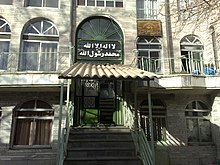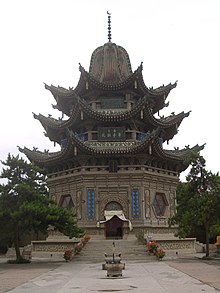Naqshbandi
| Part ofa seriesonIslam Sufism |
|---|
 |
|
|

TheNaqshbandi order(Arabic:الطريقة النقشبندية,romanized:al-Ṭarīqat al-Naqshbandiyya) is aSufiorderofSunni Islamnamed afterBaha al-Din Naqshband.They trace theirsilsila(chain) toProphet Muhammadthrough the first caliphAbu Bakr(r. 632–634) by the way ofJa'far al-Sadiq.The Naqshbandi Sufi Order is distinguished from other Sunni schools by their adherence to theshariahighlighted by major Naqshbandi scholars includingSirhindiandDahlawi.[1][2]
History[edit]
The order is also known as the "convergence of the two oceans" or "Sufi Order of Jafar al Sadiq".[3][4][5][6][7][8]The Naqshbandi order owes many insights toYusuf HamadaniandAbdul Khaliq Ghijduwaniin the 12th century, the latter of whom is regarded as the organizer of the practices and is responsible for placing stress upon the purely silentinvocation.[9]It was later associated withBaha-ud-Din Naqshband Bukhariin the 14th century, hence the name of the order. Afterward, a branch or sub-order name was added. From 'Ubeydullah Ahrar toImam Rabbani,the way was called "Naqshbandiyya-Ahrariyya"; from Imam Rabbani to Shamsuddin Mazhar "Naqshbandiyya-Mujaddadiyya"; from Shamsuddin Mazhar toKhalid al-Baghdadi"Naqshbandiyya-Mazhariyya"; from Mawlana Khalid onwards "Naqshbandiyya-Khalidiyya";"Naqshbandiyya-Mustafvi "(Khalidi) and so on.[10]
South Asia[edit]

The Naqshbandiyya order became an influential factor in Indo-Muslim life and for two centuries it was the principal spiritual order in theIndian subcontinent.Baqi Billah Berang,who was born in Kabul and brought up and educated in Kabul andSamarkand,is credited for bringing the order to India during the end of the 16th century. He tried to spread his knowledge about the order but died three years later. His discipleAhmad Sirhinditook over after his death, and it was through him that the order gained popularity within a short period of time.Shah Waliullah Dehlawiwas an 18th-century member of the order.[11]
Syria[edit]
The Naqshbandiyya order was introduced into Syria at the end of the 17th century by Murad Ali al-Bukhari, who established himself in Damascus and traveled throughout Arabia. His branch became known as the Muradiyya and was led by his descendants. In 1820, Khalid Shahrazuri rose as a prominent Naqshbandi leader in the Ottoman world and his order became known as theKhalidiyyawhich spread for at least two decades. In Syria and Lebanon, the leaders of every active Naqshbandiyya group acknowledged itsspiritual lineage.Later, a strife between Khalid's khalifas led to disruption of the order and it divide. The Farmadiyya branch, which practices silent and vocalinvocation,is still present in Lebanon and is named after Ali-Farmadi. The pre-Mujaddidi line of the Naqshbandiyya in Greater Syria came to an end when political leader Musa Bukhar died in 1973. The only branch to have survived till recently is the one based in thekhanqahal-Uzbakiyya in Jerusalem.[12]
Egypt[edit]
The Naqshbandi order rose to prominence in Egypt during the 19th century. A major khanqah was constructed in 1851 by Abbas I as a favor to the Naqshbandi sheikh Ahmad Ashiq, who led the order until his death in 1883. Ahmad Ashiq practiced the Diya'iyya branch of the Khalidiyya. Two other versions of Naqshbandiyya spread in Egypt in the last decades of the 19th century: the Judiyya, led by sheikh Juda Ibrahim, and the Khalidiyya, led by Sudanese al-Sharif Isma'il al-Sinnari and his successors. These branches continued to grow and are still active today. None of the early orders survived far into the 20th century however, and all khanqahs in Egypt were closed in 1954 when the buildings were either assigned a different function or demolished.[12]
Southeast Asia[edit]

The first known Naqshbandi murshid inMalay ArchipelagowasYusuf al-Makassari,a 17th century Islamic scholar who also introducedKhalwatiyyato the region. However, the order quickly disappeared before being introduced again in the 19th century. There are two well known branches of Naqshbandiyya ini Southeast Asia. The first one is Khalidiyya, introduced byIsmail al-Minankabawi,a disciple of Khalid al-Baghdadi and Abdullah al-Arzinjani in Mecca, and spread acrossSumatra,Java,andMalay Peninsula.PERTI,anIndonesianIslamic organization fromMinangkabau Highlands,was founded bySulaiman ar-Rasuliand other Khalidi clerics. The other branch is Mazhariyya, named after Shamsuddin Mazhar, a Naqshbandi branch through Abu Said al-Ahmadi, one of Abdullah Dehlawi's khalifas. Mazhariyya is the main Naqshbandi branch inMadura,brought by Kiai Abdul Azim after studying in Mecca. Another related order is Qadiriyya wa Naqshbandiyya, a fusion ofQadiriyyaand Naqshbandiyya, whose sheikhs inBantenandLombokled rebellions against theDutch East Indiesat the end of 19th century.[13]
China[edit]

Ma Laichibrought the Naqshbandi (نقشبندية)Nạp khắc cái ban địchorder to China, creating theKhufiyya(خفيه)Hổ phu giaHua Si SufiHoa chùa;( "Multicolored Mosque")menhuan.Ma Mingxin,also brought the Naqshbandi order, creating theJahriyya(جهرية)Triết hách lâm giamenhuan. These two menhuan were rivals, and fought against each other which led to theJahriyya Rebellion,Dungan revolt,andDungan Revolt (1895).[14]
Prominent figures[edit]
- Abdul Khaliq Ghijduwani(d. 1179), prominent sheikh whose teachings became known as the way of theKhojas(teachers) orKhwajagan(masters).
- Baha-ud-Din Naqshband Bukhari(1318–1389), the founder of the Sufi Naqshbandi Order.
- Khwaja Ahrar(1404-1490 AD), established the order in general.
- Hazrat Ishaan(1563-1642), descendant ofBaha-ud-Din Naqshband Bukhariand hereditary supreme leader of the order.
- Ahmad al-Farūqī al-Sirhindī(1564–1624), commonly known as Imam Rabbani, amujaddidand leading Naqshbandi Sheikh from India.
- Mawlana Khalid(1779–1827), the sheikh whom all the different branches of the Order in the Middle East and Caucasus spread from.
- Uthman Sirâj-ud-Dîn Naqshbandi(1781-1867), was an 18th-century influentialsufi,saintandIslamic scholar.
- Muhamamad Uthman Sirâj-ud-Dîn Naqshbandi(1896–1997), the great grandson of Uthman Sirâj-ud-Dîn Naqshbandi and leader of theSipay Rizgarigroup during the Iran-Iraq war.[15]
Principal teachings[edit]

The Naqshbandi order has eleven principle teachings known as theEleven Naqshbandi principles.The first eight were formulated byAbdul Khaliq Gajadwani,and the last three were added byBaha-ud-Din Naqshband Bukhari.[9]
- Remembrance (Yād-kard– Persian:یاد کرد): Always orally and mentally repeating thedhikr.
- Restraint (Bāz-gasht– Persian:بازگشت): Engaging in the heart repetition of the al-kalimat at-tayyiba phrase – "La-ilaha il-allah muhammadur rasul-allah".
- Watchfulness (Negāh-dāsht– Persian:نگاه داشت): Being conscientious over wandering thoughts while repeating Al-kalimat at-tayyiba.
- Recollection (Yād-dāsht– Persian:ياد داشت): Concentration upon the Divine presence in a condition ofdhawq,foretaste, intuitive anticipation or perceptiveness, not using external aids.
- Awareness while breathing (Housh dar dam– Persian:هوش در دم): Controlling one's breathing by not exhaling or inhaling in the forgetfulness of the Divine.
- Journeying in one's homeland (Safar dar watan- Persian:سفر در وطن): An internal journey that moves the person from having blameworthy to praiseworthy properties. This is also referred to as the vision or revelation of the hidden side of theshahada.
- Watching one's step (Nazar bar qadam- Persian:نظر بر قدم): Do not be distracted from purpose of the ultimate journey.
- Solitude in a crowd (Khalwat dar anjuman- Persian:خلوت در انجمن): Although journey is outwardly in this world, it is inwardly with God.
- Temporal pause (Wuquf-i zamāni- Persian:وقوف زمانی): Keeping account of how one spends his or her time. If time is spent rightfully give thanks and time is spent incorrectly ask for forgiveness.
- Numerical pause (Wuquf-i adadi- Persian:وقوف عددی): Checking that the dhikr has been repeated in odd numbers.
- Heart pause (Wuquf-i qalbi- Persian:وقوف قلبی): Forming a mental picture of one's heart with the name of God engraved to emphasize that the heart has no consciousness or goal other than God.
References[edit]
Notes[edit]
Citations[edit]
- ^Dahlawi in Maqalaat al Waziyah fi Naseehat al-Wasiyah, page 7 (Lucknow)
- ^Sirhindi in Maktubat, Volume 9:173#123
- ^Ziad, Waleed (2018). "From Yarkand to Sindh via Kabul: The Rise of Naqshbandi-Mujaddidi Sufi Networks in the Eighteenth and Nineteenth Centuries".The Persianate World: Rethinking a Shared Sphere.p. 165.doi:10.1163/9789004387287_007.ISBN9789004387287.S2CID197951160.
{{cite book}}:|work=ignored (help) - ^Milani, M.; Possamai, A.; Wajdi, F. (2017). "Branding of Spiritual Authenticity and Nationalism in Transnational Sufism". In Michel, P.; Possamai, A.; Turner, B. (eds.).Religions, Nations, and Transnationalism in Multiple Modernities.Palgrave Macmillan. pp. 197–220.doi:10.1057/978-1-137-58011-5_10.ISBN978-1-137-59238-5.
- ^Reimer, D. (1913).Die Welt des Islams Zeitschrift der Deutschen Gesellschaft für Islamkunde.p. 191.Archivedfrom the original on 23 January 2023.Retrieved4 August2022.
{{cite book}}:|work=ignored (help) - ^Zelkina, Anna (2000).Quest for God and Freedom: Sufi Responses to the Russian Advance in the North Caucasus.Hurst & Company. p. 77.ISBN9781850653844.Archivedfrom the original on 23 January 2023.Retrieved4 August2022.
Excerpt from note 11: "There are some Naqshbandi branches which trace theirsilsilathrough Ali ibn Abi Taleb. "See Algar, 1972, pp. 191-3; al-Khani, 1308. pg 6
{{cite book}}:|work=ignored (help) - ^Kugle, Scott Alan (2007).Sufis & saints' bodies: Mysticism, Corporeality and Sacred Power in Islam.University of North Carolina Press.p. 143.ISBN978-0-8078-5789-2.Archivedfrom the original on 3 December 2016.Retrieved12 August2015.
- ^Kabbani, Muhammad Hisham(2004).Classical Islam and the Naqshbandi Sufi Tradition.Islamic Supreme Council of America. p. 557.ISBN1-930409-23-0.Archivedfrom the original on 23 January 2023.Retrieved4 August2022.
- ^abTrimingham, J. Spencer (1998). "The Chief Tariqa Lines".The Sufi Orders in Islam.Oxford University Press. p.31.ISBN9780198028239.Archivedfrom the original on 23 January 2023.Retrieved4 August2022.
- ^Eraydın, Selçuk (2001).Tasavvuf ve Tarikatlar(in Turkish). Marmara Üniversitesi Ilahiyat Vakfi Yayinlari. p. 434.ISBN9789755480503.
- ^Haq, Muhammad M. (1985).Some Aspects of the Principle Sufi Orders in India.Bangladesh. p. 20.Archivedfrom the original on 23 January 2023.Retrieved4 August2022.
{{cite book}}:|work=ignored (help)CS1 maint: location missing publisher (link) - ^abDe Jong, Frederick (2000).Sufi Orders in Ottoman and Post-Ottoman Egypt and the Middle East: Collected Studies.Vol. 48, Analecta Isisiana. Isis Press.ISBN9789754281781.Archivedfrom the original on 23 January 2023.Retrieved4 August2022.
- ^van Bruinessen, Martin(1994).Tarekat Naqsyabandiyah di Indonesia(in Indonesian). Bandung: Mizan.ISBN979-433-000-0.
- ^Kees Versteegh; Mushira Eid (2005).Encyclopedia of Arabic Language and Linguistics: A-Ed.Brill. p. 380].ISBN978-90-04-14473-6.Archivedfrom the original on 3 December 2016.Retrieved24 January2016.
- ^van Bruinessen, Martin(15 August 1986).The Naqshbandi Order as a Vehicle of Political Protest among the Kurds (With Some Comparative Notes on Indonesia).New Approaches in Islamic Studies. Jakarta:Indonesian Institute of Sciences.pp. 1–3 – viaAcademia.edu.
Further reading[edit]
- Algar, Hamid (1998).Sufism: Principles and Practice.Islamic Publications International.ISBN1-889999-02-4.
- Bennett, John G. (1995).The Masters of Wisdom.Bennett Books.ISBN1-881408-01-9.
- Clayer, Nathalie,Muslim Brotherhood Networks,European History Online,Mainz:Institute of European History,2011, retrieved: 23 May 2011.
- Itzchak Weismann (2007).The Naqshbandiyya: Orthodoxy and Activism in a Worldwide Sufi Tradition.Routledge.ISBN978-0-415-32243-0.
- Sheikh Hisham Kabbani (1995).The Naqshbandi Sufi Way History and Guidebook of the Saints of the Golden Chain.[kaza publications inc].ISBN9780934905343.
- Sufism in Central AsiaA Force for Moderation or a Cause of Politicization? By Martha Brill Olcott.
External links[edit]
 Media related toNaqshbandi orderat Wikimedia Commons
Media related toNaqshbandi orderat Wikimedia Commons

